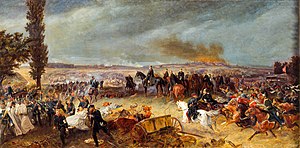| Austro-Prussian War | |||||||||
|---|---|---|---|---|---|---|---|---|---|
| Part of the wars of German unification and the Austria–Prussia rivalry | |||||||||
 Battle of Königgrätz, by Georg Bleibtreu. Oil on canvas, 1869 | |||||||||
| |||||||||
| Belligerents | |||||||||
|
Prussian-led German states
|
| ||||||||
| Commanders and leaders | |||||||||
| Strength | |||||||||
|
637,262[1] |
522,203[2]
| ||||||||
| Casualties and losses | |||||||||
|
List
| |||||||||
The Austro-Prussian War, (German: Preußisch-Österreichischer Krieg) also by many variant names such as Seven Weeks' War, German Civil War, Brothers War or Fraternal War, known in Germany as Deutscher Krieg ("German War"), Deutsch-Deutscher Krieg ("German-German War"), Deutscher Bruderkrieg (pronounced [ˌdɔʏtʃɐ ˈbʁuːdɐkʁiːk] ; "German Brothers War") and by a variety of other names, was fought in 1866 between the Austrian Empire and the Kingdom of Prussia, with each also being aided by various allies within the German Confederation. Prussia had also allied with the Kingdom of Italy, linking this conflict to the Third Independence War of Italian unification. The Austro-Prussian War was part of the wider rivalry between Austria and Prussia, and resulted in Prussian dominance over the German states.
The major result of the war was a shift in power among the German states away from Austrian and towards Prussian hegemony. It resulted in the abolition of the German Confederation and its partial replacement by the unification of all of the northern German states in the North German Confederation that excluded Austria and the other southern German states, a Kleindeutsches Reich. The war also resulted in the Italian annexation of the Austrian realm of Venetia.
- ^ Clodfelter 2017, p. 182.
- ^ a b Clodfelter 2017, p. 183.
- ^ Clodfelter 2017, pp. 183–184.